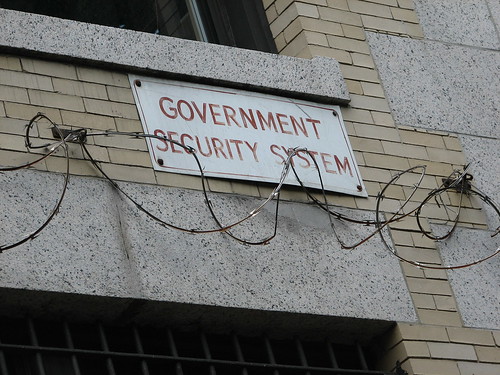Rybolov Note: this is part 2 in a series about S.773. Go read the bill here. Go read part one here. Go read part 3 here. Go read part four here. Go read part 5 here. =)
SEC. 7. LICENSING AND CERTIFICATION OF CYBERSECURITY PROFESSIONALS. This section has received quite a bit of airtime around the blagosphere. Everybody thinks that they’ll need some kind of license from the Federalies to run nessus. Hey, maybe this is how it will all end up, but I think this provision will end up stillborn.
I know the NIST folks have been working on licensing and certification for some time, but they usually run into the same problems:
- Do we certify individuals as cybersecurity professionals?
- Do we certify organizations as cybersecurity service providers?
- What can the Government do above and beyond what the industry provides? (ISC2, SANS, 27001, etc)
- NIST does not want to be in the business of being a licensure board.
Well, this is my answer (I don’t claim that these are my opinion):
- Compulsory: the Government can require certifications/licensure for certain job requirements. Right now this is managed by HR departments.
- Existing Precedent: We’ve been doing this for a couple of years with DoDI 8570.01M, which is mandatory for DoD contracts. As much as I think industry certification is a pyramid scheme, I think this makes sense in contracting for the Government because it’s the only way to ensure some kind of training for security staff.If the Government won’t pay for contractor training (and they shouldn’t) and the contractor won’t pay for employees to get training because their turnover rate is 50% in a year, it’s the only way to ensure some kind of training and professionalization of the staff. Does this scale to the rest of the country? I’m not sure.
- Governance and Oversight: The security industry has too many different factions. A Government-ran certification and license scheme would provide some measure of uniformity.
Honestly, this section of the bill might make sense (it opens up a bigger debate) except for one thing: we haven’t defined what “Cybersecurity Services” are. Let’s face it, most of what we think are “security” services are really basic IT management services… why should you need a certification to be the goon on the change control board. However, this does solve the “problem” of hackers who turn into “researchers” once they’re caught doing something illegal. I just don’t see this as that big of a problem.
Verdict: Strange that this isn’t left up to industry to handle. It smells like lobbying by somebody in ISC2 or SANS to generate a higher demand for certs. Unless this section is properly scoped and extensively defined, it needs to die on the cutting room floor–it’s too costly for almost no value above what industry can provide. If you want to provide the same effect with almost no cost to the taxpayers, consider something along the 8570.01 approach in which industry runs the certifications and specific certifications are required for certain job titles.
SEC. 8. REVIEW OF NTIA DOMAIN NAME CONTRACTS. Yes, there is a bunch of drama-llama-ing going on between NTIA, ICANN, Verisign, and a cast of a thousand. This section calls for a review of DNS contracts by the Cybersecurity Advisory Panel (remember them from section 3?) before they are approved. Think managing the politics of DNS is hard now? It just got harder–you ever try to get a handful of security people to agree on anything? And yet, I’m convinced that either this needs to happen or NTIA needs to get some clueful security staffers who know how to manage contracts.
Verdict: DNSSEC is trendy thanks to Mr Kaminski. I hate it when proposed legislation is trendy. I think this provision can be axed off the bill if NTIA had the authority to review the security of their own contracts. Maybe this could be a job for the Cybersecurity Advisor instead of the Advisory Panel?
SEC. 9. SECURE DOMAIN NAME ADDRESSING SYSTEM. OK, the Federal Government has officially endorsed DNSSEC thanks to some OMB mandates. Now the rest of the country can play along. Seriously, though, this bill has some scope problems, but basically what we’re saying is that Federal agencies and critical infrastructure will be required to implement DNSSEC.
Once again, though, we’re putting Commerce in charge of the DNSSEC strategy. Commerce should only be on the hook for the standards (NIST) and the changes to the root servers (NTIA). For the Federal agencies, this should be OMB in charge. For “critical infrastructure”, I believe the most appropriate proponent agency is DHS because of their critical infrastructure mission.
And as for the rest of you, well, if you want to play with the Government or critical infrastructure (like the big telephone and network providers), it would behoove you to get with the DNSSEC program because you’re going to be dragged kicking and screaming into this one. Isn’t the Great InfoSec Trickle-Down Effect awesome?
Verdict: If we want DNSSEC to happen, it will take an act of Congress because the industry by itself can’t get it done–too many competing interests. Add more tasks to the agencies outside of Commerce here, and it might work.

Awesome Capitol photo by BlankBlankBlank.
SEC. 10. PROMOTING CYBERSECURITY AWARENESS. Interesting in that this is tasked to Commerce, meaning that the focus is on end-users and businesses.
In a highly unscientific, informal poll with a limited sample of security twits, I confirmed that nobody has ever heard of Dewie the Webwise Turtle. Come on, guys, “Safe at any speed”, how could you forget that? At any rate, this already exists in some form, it just has to be dusted off and get a cash infusion.
Verdict: Already exists, but so far efforts have been aimed at users. The following populations need awareness: small-medium-sized businesses (SMBs), end-users, owners of critical infrastructure, technology companies, software developers. Half of these are who DHS is dealing with, and this provision completely ignores DHS’s role.
SEC. 11. FEDERAL CYBERSECURITY RESEARCH AND DEVELOPMENT. This section is awesome to read, it’s additions to the types of research that NSF can fund and extensions of funding for the existing types of research. It’s pretty hard to poke holes in, and based on back-of-the-envelope analysis, there isn’t much that is missing by way of topics that need to be added to research priorities. What I would personally like to see is a better audit system not designed around the accounting profession’s way of doing things. =)
Verdict: Keep this section intact. If we don’t fund this, we will run into problems 10+ years out–some would say we’re already running into the limitations of our current technology.
SEC. 12. FEDERAL CYBER SCHOLARSHIP-FOR-SERVICE PROGRAM. This is an existing program, and it’s pretty good. Basically you get a scholarship with a Government service commitment after graduation. Think of it as ROTC-light scholarships without bullets and trips to SW Asia.
Verdict: This is already there. This section of the bill most likely is in to get the program funded out to 2014.
Similar Posts:
 No Comments »
No Comments » Posts RSS
Posts RSS




